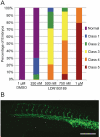Intersegmental vessel formation in zebrafish: requirement for VEGF but not BMP signalling revealed by selective and non-selective BMP antagonists
- PMID: 20718746
- PMCID: PMC2962823
- DOI: 10.1111/j.1476-5381.2010.00871.x
Intersegmental vessel formation in zebrafish: requirement for VEGF but not BMP signalling revealed by selective and non-selective BMP antagonists
Abstract
Background and purpose: Bone morphogenetic proteins (BMPs) were first identified through their role in inducing bone and cartilage formation, but many other important functions have since been ascribed to BMPs, including dorsoventral patterning, angiogenesis and tissue homeostasis. Using dorsomorphin and LDN193189, selective small molecule inhibitors of BMP signalling, we investigated the role of BMP signalling in early vascular patterning in zebrafish.
Experimental approach: The effects of dorsomorphin and LDN193189 on vascular endothelial growth factor-a (VEGF) and BMP signalling in developing zebrafish and in human pulmonary artery endothelial cells were determined using confocal microscopy, Western blotting and quantitative PCR.
Key results: We showed that dorsomorphin, similar to the VEGF inhibitor SU5416, strongly inhibits intersegmental vessel formation in zebrafish and that this is due to inhibition of VEGF activation of VEGF receptor 2 (VEGFR2), leading to reduced VEGF-induced phospho-ERK (extracellular regulated kinase) 1/2 and VEGF target gene transcription. These effects occurred at concentrations of dorsomorphin that block BMP signalling. We also showed that LDN193189, an analogue of dorsomorphin, more potently blocks BMP signalling but has no effect on VEGF signalling in zebrafish and does not disrupt early vascular patterning.
Conclusions and implications: Dorsomorphin inhibits both BMP and VEGF signalling, whereas LDN193189 is a more selective BMP antagonist. Results obtained in cardiovascular studies using dorsomorphin need to be interpreted with caution, and use of LDN193189 would be preferable due to its selectivity. Our data also suggest that BMP signalling is dispensable for early patterning of intersegmental vessels in zebrafish.
Figures





Similar articles
-
In vivo structure-activity relationship study of dorsomorphin analogues identifies selective VEGF and BMP inhibitors.ACS Chem Biol. 2010 Feb 19;5(2):245-53. doi: 10.1021/cb9002865. ACS Chem Biol. 2010. PMID: 20020776 Free PMC article.
-
Dorsomorphin inhibits BMP signals required for embryogenesis and iron metabolism.Nat Chem Biol. 2008 Jan;4(1):33-41. doi: 10.1038/nchembio.2007.54. Epub 2007 Nov 18. Nat Chem Biol. 2008. PMID: 18026094 Free PMC article.
-
Differential effects of inhibition of bone morphogenic protein (BMP) signalling on T-cell activation and differentiation.Eur J Immunol. 2012 Mar;42(3):749-59. doi: 10.1002/eji.201141702. Epub 2011 Dec 20. Eur J Immunol. 2012. PMID: 22144105
-
Applications of small molecule BMP inhibitors in physiology and disease.Cytokine Growth Factor Rev. 2009 Oct-Dec;20(5-6):409-18. doi: 10.1016/j.cytogfr.2009.10.021. Epub 2009 Nov 14. Cytokine Growth Factor Rev. 2009. PMID: 19914855 Free PMC article. Review.
-
Extracellular modulation of BMP activity in patterning the dorsoventral axis.Birth Defects Res C Embryo Today. 2006 Sep;78(3):224-42. doi: 10.1002/bdrc.20079. Birth Defects Res C Embryo Today. 2006. PMID: 17061292 Review.
Cited by
-
Loss of TDP-43 causes ectopic endothelial sprouting and migration defects through increased fibronectin, vcam 1 and integrin α4/β1.Front Cell Dev Biol. 2023 Jun 13;11:1169962. doi: 10.3389/fcell.2023.1169962. eCollection 2023. Front Cell Dev Biol. 2023. PMID: 37384248 Free PMC article.
-
Tris(1,3-dichloro-2-propyl) phosphate disrupts dorsoventral patterning in zebrafish embryos.PeerJ. 2017 Dec 14;5:e4156. doi: 10.7717/peerj.4156. eCollection 2017. PeerJ. 2017. PMID: 29259843 Free PMC article.
-
A new class of small molecule inhibitor of BMP signaling.PLoS One. 2013 Apr 30;8(4):e62721. doi: 10.1371/journal.pone.0062721. Print 2013. PLoS One. 2013. PMID: 23646137 Free PMC article.
-
Endorepellin-evoked Autophagy Contributes to Angiostasis.J Biol Chem. 2016 Sep 9;291(37):19245-56. doi: 10.1074/jbc.M116.740266. Epub 2016 Jul 19. J Biol Chem. 2016. PMID: 27435676 Free PMC article.
-
Hypoxia-induced retinal neovascularization in zebrafish embryos: a potential model of retinopathy of prematurity.PLoS One. 2015 May 15;10(5):e0126750. doi: 10.1371/journal.pone.0126750. eCollection 2015. PLoS One. 2015. PMID: 25978439 Free PMC article.
References
-
- Boyd NL, Dhara SK, Rekaya R, Godbey EA, Hasneen K, Rao RR, et al. BMP4 promotes formation of primitive vascular networks in human embryonic stem cell-derived embryoid bodies. Exp Biol Med (Maywood) 2007;232:833–843. - PubMed
-
- Carmeliet P, Ferreira V, Breier G, Pollefeyt S, Kieckens L, Gertsenstein M, et al. Abnormal blood vessel development and lethality in embryos lacking a single VEGF allele. Nature. 1996;380:435–439. - PubMed
Publication types
MeSH terms
Substances
Grants and funding
LinkOut - more resources
Full Text Sources
Molecular Biology Databases
Miscellaneous

